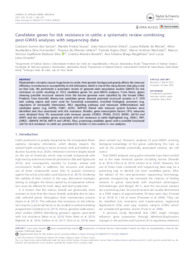Candidate genes for tick resistance in cattle: a systematic review combining post-GWAS analyses with sequencing data.
Candidate genes for tick resistance in cattle: a systematic review combining post-GWAS analyses with sequencing data.
Autoria: SANTOS, C. G. dos; SOUSA, M. F.; VIEIRA, J. I. G.; MORAIS, L. R. de; FERNANDES, A. A. S.; LITTIERE, T. de O.; OTTO, P. I.; MACHADO, M. A.; SILVA, M. V. G. B.; BONAFÉ, C. M.; MAGALHÃES, A. F. B.; VERARDO, L. L.
Resumo: Rhipicephalus microplus causes huge losses in cattle. Host genetic background greatly affects the immune efficiency in resistance or susceptibility to tick infestation, which is one of the many factors that play a role on that trait. We performed a systematic review of genome-wide association studies (GWAS) for tick resistance in cattle resulting in 1353 candidate genes for post-GWAS analyses. From those, genes showing possible structural variants from the bovine genome were classified by the Variant Effect Predictor from Ensembl. Ninety-two candidate genes showed potential structural variants in 5' UTR and coding region and were used for functional annotation. Enriched biological processes (e.g. regulation of eosinophil chemotaxis, RIG-I signalling pathway and monocyte differentiation) and candidate genes (e.g. DAPK2, PUM1, ACIN1, INPP5D) linked with immune system function were identified and thus associated with tick resistance. Besides, gene-transcription factors (TFs) networks were obtained from TFs associated with immune system (FOXO3, PPARG, STAT3, NFKB1, GATA3 and ARNT) and the candidate genes associated with tick resistance in cattle highlighted (e.g. OR4L1, PNP, LRRIQ1, GIMAP8, MYO6, MEP1A and LRFN2). Thus, promising candidate genes with a possible functional role for tick resistance in cattle are presented for further in vitro and/or in vivo analyses.
Ano de publicação: 2022
Tipo de publicação: Artigo de periódico
Unidade: Embrapa Gado de Leite
Palavras-chave: Bovino, Carne, Carrapato, Ectoparasita, Genoma, Hospedeiro Animal, Sistema imunológico
Observações
1 - Por padrão são exibidas publicações dos últimos 20 anos. Para encontrar publicações mais antigas, configure o filtro ano de publicação, colocando o ano a partir do qual você deseja encontrar publicações. O filtro está na coluna da esquerda na busca acima.
2 - Para ler algumas publicações da Embrapa (apenas as que estão em formato ePub), é necessário ter, no celular ou computador, um desses softwares gratuitos. Sistemas Android: Google Play Livros; IOS: iBooks; Windows e Linux: software Calibre.
Acesse outras publicações
Acesse a Base de Dados da Pesquisa Agropecuária (BDPA) para consultar o acervo completo das bibliotecas da Embrapa.

